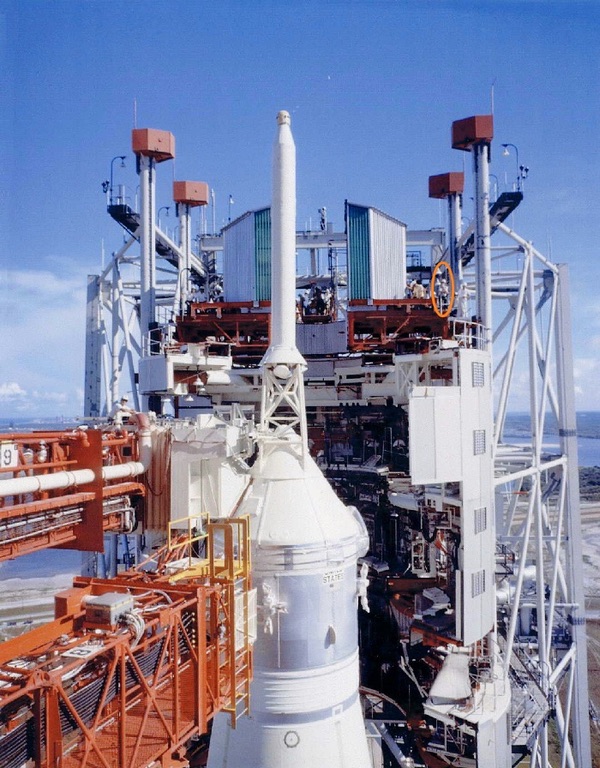Top man on the Saturn Vby Thomas Frieling
|
| The Mobile Service Structure (MSS) was retracted and the cover protected the Q-Ball from the elements—and the seagulls—until launch. |
The Q-Ball, mounted on the tip of the Saturn V’s Launch Escape System (LES), was a device that measured dynamic pressure on the vehicle through several ports so that the Saturn V’s angle of attack could be controlled as to not exceed the structural limits on the rocket. It was not unlike an aircraft’s pitot tube.
“Max Q” was measured by the Q-Ball when the combination of velocity and air density maxed out. These measurements provided constant inputs to the Saturn’s Instrument Unit to keep the launch vehicle on the correct trajectory.
Why did it need a cover?
Mainly to keep the ports from getting pooped on and clogged up by seagulls, to be quite honest about it.
Inside the VAB, the area around the LES was enclosed, so the Q-Ball was protected. With the Saturn V at the pad, the Mobile Service Structure protected the Q-Ball while it was in place cradling the stack. We then rigged and tested the flight cover to support the Countdown Demonstration Test (CDDT) and the actual countdown. Afterwards, the Mobile Service Structure (MSS) was retracted and the cover protected the Q-Ball from the elements—and the seagulls—until launch.
Since the cover absolutely, positively needed to retract at launch, how were you sure it was fail-safe?
I wrote all the Q-Ball Cover Retraction System test and countdown procedures and it was tested several times before each launch. We never had a failure even though the retraction device had quite a collection of moving parts—rubber bands, a wire cutter, a counter-weight, and a pneumatic piston—all designed to cut the cover in two at T-8.9 seconds, the moment of Ignition Sequence Start.
I often wondered what would have happened if the retraction system somehow failed. But I don’t think a rising Saturn V would have noticed that a one-eighth-inch steel cable was still attached to the Launch Umbilical Tower (LUT). The cover would have been ripped off.
Given the inferno created by the Saturn V’s F-1 engines, is it safe to assume the Q-Ball cover was incinerated after the launch?
It was probably incinerated or at least blown to bits. However, I do have, as a souvenir, a small piece of the Apollo 11 cover that was recovered out at the pad post-launch.
Accounts of the KSC work force on Pad 39 tell of more than one worker freezing up with fear of heights, unable to work at the 400-foot [120-meter] level of the Launch Umbilical Tower. What was it like working on open grates 400 feet above the launcher deck?
| I often wondered what would have happened if the retraction system somehow failed. But I don’t think a rising Saturn V would have noticed that a one-eighth-inch steel cable was still attached to the Launch Umbilical Tower (LUT). |
I had no problem working on the upper levels of the LUT. The pulley for the retraction system was attached to the Hammerhead crane catwalk, so the rigging procedure involved walking out about halfway on an open grate. There was nothing between you and the ground level, a distance of almost 500 feet.
As a safety requirement, we had to wear safety harnesses and keep secured to the catwalk railing. Nobody needed to remind me to comply, and I tried to keep one hand firmly gripping the railing. Everybody had to wear hardhats at the pad, and chin straps were required above the “0” level.
Could you describe your duties on launch day 50 years ago?
The countdown had been proceeding for several days prior to July 16. Being the newest (and youngest) engineer in the group, I pulled the midnight shift to man the pneumatics and hydraulics consoles in the Launch Control Center (LCC) Firing Room. I was relieved at 4 am, grabbed some breakfast at the LCC cafeteria, then got my 35mm slide and Super 8 movie cameras out of my car and set up between the Press Site and the Turning Basin. After launch, I stowed my gear in the car and went back into the Firing Room to listen to the speeches, one by Vice President Spiro Agnew.
I then took the cover of our copy of the countdown manual and had it autographed by Alan Shepard, Deke Slayton, [KSC Director] Kurt Debus, Jim McDivitt, and Wernher von Braun.
I hope you still have that manual.
I still have the cover sheet, not the entire manual. Unfortunately, von Braun and McDivitt must have had cheap pens, as their signatures have faded away.
| I’m glad I wasn’t in the Firing Room for the liftoff. That would have been way too stressful for me. |
I’m sure you’ve seen the recent documentary Apollo 11 with its never before seen large format 70mm footage. Buzz Aldrin said it made him feel like he was back in time at the Cape for launch day.
Yes, I did. I enjoyed it so much that I went back to see it again a few days later. The liftoff sequence gave me chills both times.
Finally, is there any part of launch day you’d like to re-live?
I’m glad I wasn’t in the Firing Room for the liftoff. That would have been way too stressful for me. But I would like to relive when I was out at the Turning Basin, viewing the launch. So much anticipation and excitement, the sights and sounds of the liftoff; a truly exciting time.
Note: we are temporarily moderating all comments subcommitted to deal with a surge in spam.
